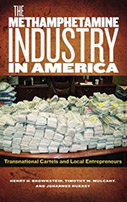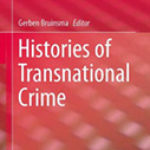The Methamphetamine Industry in America: Transnational Cartels and Local Entrepreneurs

Authors: Henry R. Brownstein, Timothy M. Mulcahy, and Johannes Huessy.
Publisher: New Brunswick, NJ: Rutgers University Press, 2014. 172p.
Reviewer: Ralph A. Weisheit | March 2015
Like marijuana, methamphetamine is an illicit drug associated both with domestic drug production and with imported product from Mexico. This book examines the business of methamphetamine, including both domestic and imported sources. It does this from a sociological perspective, with a focus on the social organization of the industry.
The study upon which this book is based is an impressive one in its scale, its scope, and its utilization of multiple methodologies. The methodology alone deserves some discussion. Conducted over a period of four years, the study “was designed to incorporate a national perspective with a local orientation” (p. 24). Researchers began with a national survey of over 1,300 police agencies. Responses to the survey were used to identify three types of methamphetamine markets: those with methamphetamine primarily supplied by local markets, those with methamphetamine primarily supplied by import markets, and those with both types of markets. They then conducted telephone interviews with representatives of 50 police agencies representing these three types of markets. Simultaneous to the telephone interviews, a web-based program and geocoding software allowed respondents to supply photographs, written documents, and precise geographic locations of methamphetamine seizures. Based on the findings of their survey and interviews, the researchers selected five regions within the United States for more in-depth data collection and site visits. Sites were selected for visits based on the apparent characteristics of the methamphetamine markets and on the availability of a wide range of individuals familiar with the issue in that area, including methamphetamine dealers and cooks, treatment providers, and family service providers.
The emphasis throughout is on the social relationships that make each type of methamphetamine industry function. Three findings are particularly worth noting. First, is the relative absence of violence as part of the methamphetamine business. While domestic violence by users is a concern, there was little evidence of violence linked to turf battles or the business of distributing methamphetamine. This was even true in communities supplied by Mexican trafficking organizations. The second finding was that the business of methamphetamine was different from that for cocaine or heroin. In particular, methamphetamine distribution and sales were primarily among individuals who knew and trusted each other. This was true not only for small “mom-and-pop” domestic operations, but for those run by Mexican drug organizations. In nearly every place they visited, researchers were told it would be very difficult for them to purchase methamphetamine without having some personal connection to the seller. So-called “cold buys” associated with urban street sales of cocaine seldom happened with methamphetamine, regardless of the structure of the local market. The third important finding is that in many areas methamphetamine use is intergenerational. While local studies had suggested as much, this is the first to suggest the pattern may be widespread.
This book makes an important contribution to understanding the methamphetamine industry in America. It also serves as a model for good research on a variety of issues. And, like any good book, it leaves the reader wanting more.
Ralph A. Weisheit, Distinguished Professor of Criminal Justice, Illinois State University


